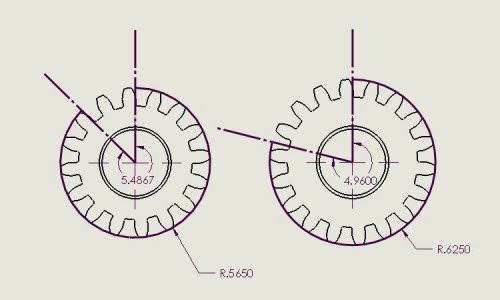I just stumbled across an "advert" that resembles what I see on eBay. Very nice gears, but no sizes, tooth counts, or pitch. A pretty picture but no useful information. It brought to mind an old timers trick. With a piece of light sheet metal, roof flashing works good, cut a notch three point one (3.1) inches long. Wrap the sheet metal around the gear, the number of exposed teeth is the DP for that gear. If it is a very(!) large gear, make the notch 6.2 inches, if a very small gear, 1.6 inches. Then adjust the tooth count to match the multiple of the gauge.
The difference between 14, 16, and 18 DP gears is hard to judge by eye. Such a gauge is handy for that. It doesn't figure in pressure angle, but for older gears, 14-1/2 degree is a good guess. Metric modulus gears are simple enough to measure, sometimes DP is a problem. A quick and dirty solution.
EDIT: Corrected the larger size notch.
.
The difference between 14, 16, and 18 DP gears is hard to judge by eye. Such a gauge is handy for that. It doesn't figure in pressure angle, but for older gears, 14-1/2 degree is a good guess. Metric modulus gears are simple enough to measure, sometimes DP is a problem. A quick and dirty solution.
EDIT: Corrected the larger size notch.
.
Last edited:




 Having slept on the matter, it occurs to me that you are correct. The guage you point to is correct. My memory may well be playing a little game with me. The stroke that put me in a wheelchair was the sixth. Somewhere along the line, one may have taken part of my memory. If, for smaller gears in the 14-18 DP range, a gear had, say, 150 teeth, it would be necessary to add 2 to the total exposed. It has been well over 20 years since I last used the technique myself. I recalled having used it on a "salvage" operation. It did work, when I got the gears home I matched them to my Atlas(Craftsman) built machine, where they did match. The machine was not "commissioned" at the time, just sitting on sawhorses. The gears I had "acquired" were not for the Atlas specifically, I just liked the size (DP) of them. They (dozens) mostly ended up on a shelf. I have used some. . . The rest are just sitting there.
Having slept on the matter, it occurs to me that you are correct. The guage you point to is correct. My memory may well be playing a little game with me. The stroke that put me in a wheelchair was the sixth. Somewhere along the line, one may have taken part of my memory. If, for smaller gears in the 14-18 DP range, a gear had, say, 150 teeth, it would be necessary to add 2 to the total exposed. It has been well over 20 years since I last used the technique myself. I recalled having used it on a "salvage" operation. It did work, when I got the gears home I matched them to my Atlas(Craftsman) built machine, where they did match. The machine was not "commissioned" at the time, just sitting on sawhorses. The gears I had "acquired" were not for the Atlas specifically, I just liked the size (DP) of them. They (dozens) mostly ended up on a shelf. I have used some. . . The rest are just sitting there.